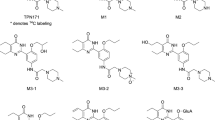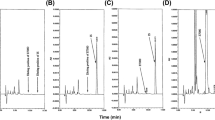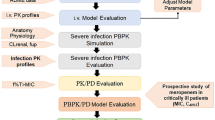Abstract
Aim:
TPN729MA is a novel selective PDE5 inhibitor currently under clinical development in China for the treatment of erectile dysfunction. In this study we characterized its preclinical pharmacokinetics (PK) and predict its human PK using a physiologically based pharmacokinetic (PBPK) model.
Methods:
The preclinical PK of TPN729MA was studied in rats and dogs. Human clearance (CL) values for TPN729MA were predicted from various allometric methods and from intrinsic CL determined in human liver microsomes. Human PK and plasma concentration versus time profiles of TPN729MA were predicted by using a PBPK model in GastroPlus. Considering the uncertainties in the prediction, a preliminary human study was conducted in 3 healthy male volunteers with an oral dose of 25 mg.
Results:
After a single intravenous administration of TPN729MA at a dose of 1 mg/kg in rats and 3 mg/kg in dogs, the plasma CL was 69.7 mL·min−1·kg−1 in rats and 26.3 mL·min−1·kg−1 in dogs, and the steady-state volumes of distribution (Vss) were 7.35 L/kg in rats and 6.48 L/kg in dogs. The oral bioavailability of TPN729MA was 10% in rats and above 34% in dogs. Profiles of predicted plasma concentration versus time were similar to those observed in humans at 25 mg, and the predicted Tmax, Cmax and AUC values were within 2-fold of the observed values.
Conclusion:
TPN729MA demonstrates good preclinical PK. This compound is a valuable candidate for further clinical development. This study shows the benefits of using a PBPK model to predict PK in humans.
Similar content being viewed by others
Log in or create a free account to read this content
Gain free access to this article, as well as selected content from this journal and more on nature.com
or
References
Hong K, Xu QQ, Zhao YP, Gu YQ, Jiang H, Wang XF, et al. Andrology in China: current status and 10 years' progress. Asian J Androl 2011; 13: 512–8.
Zhang K, Xu B, Liu D, Wang X, Zhu J, Deng C, et al. Sildenafil improves erectile hardness in Chinese men with erectile dysfunction: a real-life study analyzed on age stratification. Urology 2014; 83: 831–6.
Gupta M, Kovar A, Meibohm B . The clinical pharmacokinetics of phosphodiesterase-5 inhibitors for erectile dysfunction. J Clin Pharmacol 2005; 45: 987–1003.
Francis SH, Corbin JD . Molecular mechanisms and pharmacokinetics of phosphodiesterase-5 antagonists. Curr Urol Rep 2003; 4: 457–65.
Corbin JD, Francis SH . Pharmacology of phosphodiesterase-5 inhibitors. Int J Clin Pract 2002; 56: 453–9.
Rezvanfar MA, Rahimi HR, Abdollahi M . ADMET considerations for phosphodiesterase-5 inhibitors. Expert Opin Drug Metab Toxicol 2012; 8: 1231–45.
Bruzziches R, Francomano D, Gareri P, Lenzi A, Aversa A . An update on pharmacological treatment of erectile dysfunction with phosphodiesterase type 5 inhibitors. Expert Opin Pharmacother 2013; 14: 1333–44.
Bell AS, Palmer MJ . Novel phosphodiesterase type 5 modulators: a patent survey (2008-2010). Expert Opin Ther Pat 2011; 21: 1631–41.
Wang Z, Zhu DF, Yang XC, Li JF, Jiang XR, Tian GH, et al. The selectivity and potency of the new PDE5 inhibitor TPN729MA. J Sex Med 2013; 10: 2790–7.
Ring BJ, Chien JY, Adkison KK, Jones HM, Rowland M, Jones RD, et al. PhRMA CPCDC initiative on predictive models of human pharmacokinetics, part 3: Comparative assessment of prediction methods of human clearance. J Pharm Sci 2011; 100: 4090–110.
Hosea NA, Collard WT, Cole S, Maurer TS, Fang, RX, Jones HM, et al. Prediction of human pharmacokinetics from preclinical information: comparative accuracy of quantitative prediction approaches. J Clin Pharmacol 2009; 49: 513–33.
De Buck SS, Sinha VK, Fenu LA, Gilissen RA, Mackie CE, Nijsen MJ . The prediction of drug metabolism, tissue distribution, and bioavailability of 50 structurally diverse compounds in rat using mechanism-based absorption, distribution, and metabolism prediction tools. Drug Metab Dispos 2007; 35: 649–59.
Jones HM, Parrott N, Jorga K, Lave T . A novel strategy for physiologically based predictions of human pharmacokinetics. Clin Pharmacokinet 2006; 45: 511–42.
Poulin P, Theil FP . Prediction of pharmacokinetics prior to in vivo studies. 1. Mechanism-based prediction of volume of distribution. J Pharm Sci 2002; 91: 129–56.
Berezhkovskiy LM . Volume of distribution at steady state for a linear pharmacokinetic system with peripheral elimination. J Pharm Sci 2004; 93: 1628–40.
Rodgers T, Leahy D, Rowland M . Physiologically based pharmacokinetic modeling 1: predicting the tissue distribution of moderate-to-strong bases. J Pharm Sci 2005; 94: 1259–76.
Rodgers T, Rowland M . Physiologically based pharmacokinetic modelling 2: predicting the tissue distribution of acids, very weak bases, neutrals and zwitterions. J Pharm Sci 2006; 95: 1238–57.
Tang H, Mayersohn M . A novel model for prediction of human drug clearance by allometric scaling. Drug Metab Dispos 2005; 33: 1297–303.
Tang H, Hussain A, Leal M, Mayersohn M, Fluhler E . Interspecies prediction of human drug clearance based on scaling data from one or two animal species. Drug Metab Dispos 2007; 35: 1886–93.
Agoram B, Woltosz WS, Bolger MB . Predicting the impact of physiological and biochemical processes on oral drug bioavailability. Adv Drug Deliv Rev 2001; 50: S41–67.
Yu LX, Amidon GL . A compartmental absorption and transit model for estimating oral drug absorption. Int J Pharm 1999; 186: 119–25.
Allan G, Davis J, Dickins M, Gardner I, Jenkins T, Jones H, et al. Pre-clinical pharmacokinetics of UK-453,061, a novel non-nucleoside reverse transcriptase inhibitor (NNRTI), and use of in silico physiologically based prediction tools to predict the oral pharmacokinetics of UK-453,061 in man. Xenobiotica 2008; 38: 620–40.
Bungay PJ, Tweedy S, Howe DC, Gibson KR, Jones HM, Mount NM . Preclinical and clinical pharmacokinetics of PF-02413873, a nonsteroidal progesterone receptor antagonist. Drug Metab Dispos 2011; 39: 1396–405.
Yamazaki S, Skaptason J, Romero D, Vekich S, Jones HM, Tan W, et al. Prediction of oral pharmacokinetics of cMet kinase inhibitors in humans: physiologically based pharmacokinetic model versus traditional one-compartment model. Drug Metab Dispos 2011; 39: 383–93.
Xia B, Heimbach T, He H, Lin TH . Nilotinib preclinical pharmacokinetics and practical application toward clinical projections of oral absorption and systemic availability. Biopharm Drug Dispos 2012; 33: 536–49.
Liu F, Zhuang XM, Yang CP, Li Z, Xiong S, Zhang ZW, et al. Characterization of preclinical in vitro and in vivo ADME properties and prediction of human PK using a physiologically based pharmacokinetic model for YQA-14, a new dopamine D3 receptor antagonist candidate for treatment of drug addiction. Biopharm Drug Dispos 2014; 35: 296–307.
Li GF, Wang K, Chen R, Zhao HR, Yang J, Zheng QS . Simulation of the pharmacokinetics of bisoprolol in healthy adults and patients with impaired renal function using whole-body physiologically based pharmacokinetic modeling. Acta Pharmacol Sin 2012; 33: 1359–71.
Jones HM, Gardner IB, Collard WT, Stanley PJ, Oxley P, Hosea NA, et al. Simulation of human intravenous and oral pharmacokinetics of 21 diverse compounds using physiologically based pharmacokinetic modelling. Clin Pharmacokinet 2011; 50: 331–47.
Jones HM, Dickins M, Youdim K, Gosset JR, Attkins NJ, Hay TL, et al. Application of PBPK modelling in drug discovery and development at Pfizer. Xenobiotica 2012; 42: 94–106.
Sinha VK, Snoeys J, Osselaer NV, Peer AV, Mackie C, Heald D . From preclinical to human-prediction of oral absorption and drug-drug interaction potential using physiologically based pharmacokinetic (PBPK) modeling approach in an industrial setting: a workflow by using case example. Biopharm Drug Dispos 2012; 33: 111–21.
De Buck SS, Sinha VK, Fenu LA, Nijsen MJ, Mackie CE, Gilissen RA . Prediction of human pharmacokinetics using physiologically based modeling: a retrospective analysis of 26 clinically tested drugs. Drug Metab Dispos 2007; 35: 1766–80.
Poulin P, Jones R, Jones HM, Gibson CR, Rowland M, Chien JY, et al. PHRMA CPCDC initiative on predictive models of human pharmacokinetics, part 5: Prediction of plasma concentration-time profiles in human by using the physiologically-based pharmacokinetic modeling approach. J Pharm Sci 2011; 100: 4127–57.
Chen Y, Jin JY, Mukadam S, Malhi V, Kenny JR . Application of IVIVE and PBPK modeling in prospective prediction of clinical pharmacokinetics: strategy and approach during the drug discovery phase with four case studies. Biopharm Drug Dispos 2012; 33: 85–98.
Jones HM, Gardner IB, Watson KJ . Modelling and PBPK simulation in drug discovery. AAPS J 2009; 11: 155–66.
Author information
Authors and Affiliations
Corresponding authors
Rights and permissions
About this article
Cite this article
Gao, Zw., Zhu, Yt., Yu, Mm. et al. Preclinical pharmacokinetics of TPN729MA, a novel PDE5 inhibitor, and prediction of its human pharmacokinetics using a PBPK model. Acta Pharmacol Sin 36, 1528–1536 (2015). https://doi.org/10.1038/aps.2015.118
Received:
Accepted:
Published:
Issue date:
DOI: https://doi.org/10.1038/aps.2015.118
Keywords
This article is cited by
-
Metabolic characterization of a potent natural neuroprotective agent dendrobine in vitro and in rats
Acta Pharmacologica Sinica (2022)
-
Species differences in the CYP3A-catalyzed metabolism of TPN729, a novel PDE5 inhibitor
Acta Pharmacologica Sinica (2021)
-
A Review of Current Methods for Food Effect Prediction During Drug Development
Current Pharmacology Reports (2020)
-
Development of a Physiologically Based Pharmacokinetic Model for Sinogliatin, a First-in-Class Glucokinase Activator, by Integrating Allometric Scaling, In Vitro to In Vivo Exploration and Steady-State Concentration–Mean Residence Time Methods: Mechanistic Understanding of its Pharmacokinetics
Clinical Pharmacokinetics (2018)



